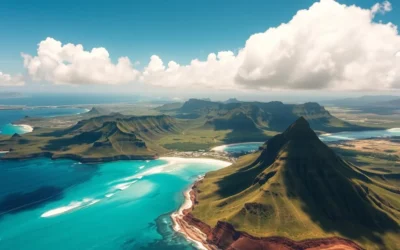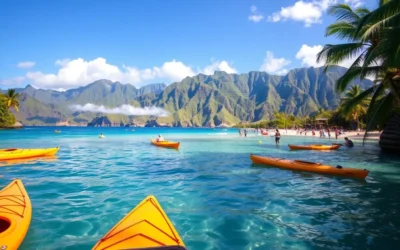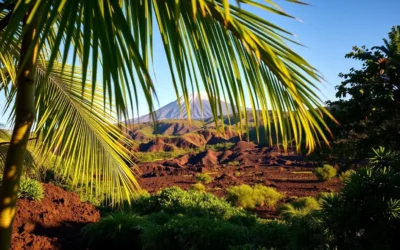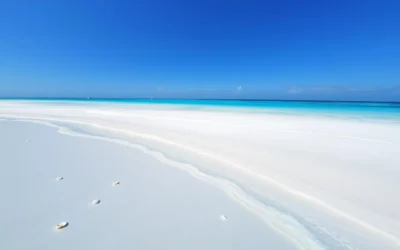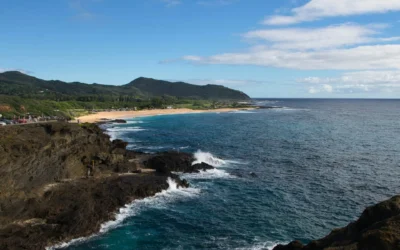✓ Accommodations ✓ Flights ✓ Rental Cars ✓ Tours & Activities
Imagine standing on a beach where the sand is as black as coal, and the ocean sparkles with turquoise waters. Welcome to Waiʻānapanapa State Park, a place of volcanic wonder and sacred history. Located along the rugged coastline of East Maui, this park is a must-visit destination for anyone drawn to natural beauty and rich cultural heritage.
The park’s unique landscape, shaped by volcanic forces, features a striking black sand beach, sea arches, lava tubes, and native hala forests. As you explore this breathtaking natural wonder, you’ll discover the cultural significance and ancient legends that make Waiʻānapanapa a truly special place. With its dramatic contrasts between jet-black shores, lush green foliage, and the brilliant blue Pacific Ocean, this park is a photographer’s paradise.
Discovering Waiʻānapanapa: A Natural Wonder on Maui’s Coast
As you step into Waiʻānapanapa State Park, you’re immediately enveloped in a world of natural beauty. This enchanting park on Maui’s coast is a treasure trove of unique landscapes and features that showcase the island’s diverse natural wonder.
What Makes Waiʻānapanapa Special
Waiʻānapanapa State Park stands out due to its stunning natural beauty and rich cultural heritage. The park’s unique freshwater pools, formed within volcanic rock, are a highlight, offering a glimpse into the island’s geological history.
| Feature | Description | Significance |
|---|---|---|
| Freshwater Pools | Pools formed within volcanic rock | Unique geological feature |
| Cultural Significance | Rich history and legends | Important to Hawaiian heritage |
| Natural Beauty | Diverse landscapes and ecosystems | Showcases Maui’s natural wonder |
The Meaning Behind the Name
The name “Waiʻānapanapa” translates to “glistening fresh water,” a reference to the park’s lava rock pools that shimmer in the sunlight. This name reflects the park’s most distinctive feature and highlights the spiritual significance of these natural wonders to early Hawaiians.

Understanding the meaning behind Waiʻānapanapa enhances your appreciation of the park, allowing you to see it through the eyes of those who have treasured this land for generations.
Essential Visitor Information for Waiʻānapanapa State Park
To ensure a smooth and enjoyable experience at Waiʻānapanapa, it’s crucial to understand the park’s visitor guidelines. This includes knowing the location, reservation requirements, fees, and operating hours.
Location and Directions
Waiʻānapanapa State Park is located along the Road to Hana on Maui, Hawaii. To get there, follow the highway (Route 360) about 45 miles east of Kahului, or roughly 10 miles past the town of Paia. The park’s address is 100 Hana Highway, Hana, HI 96713.
Reservation Requirements
Waiʻānapanapa State Park operates daily with four distinct reservation time slots: early morning (7:00 AM – 10:00 AM), midday (10:00 AM – 12:30 PM), early afternoon (12:30 PM – 3:00 PM), and late afternoon (3:00 PM – 6:00 PM). You must arrive during your designated time slot. Late arrivals will be denied entry, and if you arrive near the end of your slot, you may not be admitted if staff determines you won’t have adequate time to enjoy the park.
- The early morning slot is highly recommended for photographers and those seeking a more serene experience.
- Consider the midday slots if you’re incorporating Waiʻānapanapa into a full Road to Hana itinerary.
- The late afternoon slot offers beautiful golden hour lighting but means you’ll likely be driving back in darkness.
Entrance and Parking Fees
There is a fee to enter Waiʻānapanapa State Park. The current fee is $5 per vehicle for Hawaii residents and $15 per vehicle for non-residents. Parking is included with the entrance fee.
Operating Hours and Best Time Slots
The park is open daily. The four reservation time slots are designed to manage visitor numbers. The best time to visit depends on your preferences for crowds and lighting.
Planning Your Visit Based on Reservation Time
The key to a memorable experience at Waiʻānapanapa lies in planning your visit according to your reservation time. This ensures that you make the most of your trip and enjoy the park’s natural beauty without the crowds.
Morning Reservation Strategy
Visiting in the morning can be a great way to beat the heat and the crowds. Arrive early, and you’ll have a better chance to explore the park’s attractions, such as the black sand beach, without the peak tourist traffic.
Afternoon Reservation Tips
If your reservation is in the afternoon, consider exploring the park’s shaded areas and cultural sites first. This strategy allows you to enjoy the park’s highlights while avoiding the midday sun.
Hawaii Residents Information
As a Hawaii resident, or kamaʻāina, you can visit Waiʻānapanapa State Park for free without an advance reservation. Simply present your valid Hawaii state ID at the entrance. This policy allows locals to enjoy their natural resources while recognizing the importance of preserving these areas for future generations.
| Visitor Type | Reservation Requirement | Admission Fee |
|---|---|---|
| Hawaii Residents | No | Free |
| Non-Residents | Yes | Applicable fee |

Must-See Natural Attractions at Waiʻānapanapa
From its famous black sand beach to its serene freshwater pools, Waiʻānapanapa offers a range of natural attractions to explore. As you visit Waiʻānapanapa State Park, you’ll discover a variety of natural wonders that are sure to captivate your senses.
The Famous Black Sand Beach
The black sand beach at Waiʻānapanapa is one of its most striking features. Formed by the erosion of volcanic rocks, the beach’s dark sand is a dramatic contrast to the more common golden sands found elsewhere. This unique landscape is a result of centuries of volcanic activity, and it’s a must-see during your visit.
Sea Caves and Lava Tubes
Waiʻānapanapa is also home to fascinating sea caves and lava tubes. These natural formations were created by volcanic activity and the relentless pounding of the ocean against the shore. Exploring these caves offers a glimpse into the park’s geological history.
Blowholes and Sea Arches
The park’s rugged coastline is dotted with blowholes and sea arches, natural wonders that have been shaped by the constant interaction between the sea and the volcanic rock. These features are not only visually striking but also provide insight into the park’s unique geology.
Freshwater Pools
Waiʻānapanapa’s name, meaning “glistening waters,” refers to the freshwater pools found within the park. These pools, formed in depressions in the lava rock and fed by underground springs, are serene oases amidst the volcanic landscape. They hold significant cultural value and are associated with Hawaiian legends.
| Attraction | Description |
|---|---|
| Black Sand Beach | Formed by volcanic rock erosion |
| Sea Caves and Lava Tubes | Created by volcanic activity and ocean erosion |
| Blowholes and Sea Arches | Shaped by sea and volcanic rock interaction |
| Freshwater Pools | Fed by underground springs, cultural significance |

Hiking and Activities in Waiʻānapanapa State Park
Waiʻānapanapa State Park offers a variety of activities for visitors to enjoy its natural beauty. Whether you’re interested in hiking, swimming, or camping, the park has something for everyone.
Waianapanapa Coastal Trail (Ke Ala Loa o Maui)
The Waianapanapa Coastal Trail, also known as Ke Ala Loa o Maui, is a scenic hiking trail that offers breathtaking views of the coastline. This trail is perfect for those who want to experience the park’s natural beauty up close. As you hike, you’ll have the opportunity to see the park’s unique geological features, including sea caves and blowholes.

Swimming and Beach Safety
While swimming at Waiʻānapanapa’s black sand beach can be tempting, it’s essential to exercise caution. The ocean conditions can be hazardous, so be sure to check the park’s safety guidelines before entering the water. Always swim at designated areas and follow park rules to ensure a safe and enjoyable experience.
Camping Options
For those who want to immerse themselves in the park’s tranquility, Waiʻānapanapa offers camping options for tents and cabins. You can book a site for $18 or a cabin for $90 per night. The campground provides basic amenities, including restrooms, outdoor showers, and drinking water stations. Be sure to bring your own camping equipment or arrange for rentals.
Cultural Significance and Respectful Visitation
As you step into Waiʻānapanapa State Park, you’re not just entering a scenic destination; you’re entering a sacred landscape steeped in ancestral connections and stories. The park is a testament to the rich cultural heritage of Native Hawaiians, with numerous historical and spiritual sites.
The Legend of Princess Popoalaea
The legend of Princess Popoalaea is deeply intertwined with the history of Waiʻānapanapa. According to lore, the princess’s tragic love story is connected to the park’s natural features. This legend adds a layer of mystique to the park’s already breathtaking beauty.
Sacred Sites and Cultural Etiquette
When visiting Waiʻānapanapa, it’s essential to practice cultural etiquette. This includes staying on marked trails, not removing rocks or sand, and avoiding disturbance to sacred areas and burial sites. The park’s ocean views and natural beauty are awe-inspiring, and respecting these sites ensures their preservation for future generations.
| Cultural Practice | Significance |
|---|---|
| Staying on marked trails | Preserves sacred sites and prevents erosion |
| Not removing rocks or sand | Respects Native Hawaiian cultural beliefs and preserves the park‘s natural state |
| Avoiding loud music or drones | Maintains the serene atmosphere and shows respect for the land’s spiritual significance |

Conclusion: Making the Most of Your Waiʻānapanapa Experience
Your journey to Waiʻānapanapa State Park promises to be an enriching experience, filled with opportunities to explore and discover. To fully immerse yourself in the park’s natural beauty and cultural significance, plan your visit thoughtfully. Secure your reservations in advance, especially during peak travel seasons, and arrive during your designated time slot.
As you explore, balance your time between the black sand beach, lava tubes, and less-visited areas like the coastal trail. Approach your visit with respect for both the natural environment and cultural history. With proper planning and an open heart, your visit will become one of your most treasured memories of Maui.
The above is subject to change.
Check back often to TRAVEL.COM for the latest travel tips and deals.


